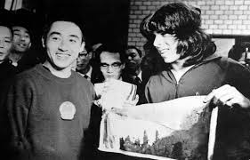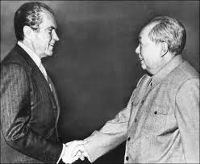Ping Pong Diplomacy
It was called "the Ping heard round the world" by one newsmagazine. It was a sporting event that showed, even in some small way, that two political enemies could engage in nonviolent competition. It is most often referred to as Ping Pong Diplomacy. China and the Soviet Union and the United States had been allies in World War II, working together in a manner of speaking to defeat Germany, Italy, and Japan. After that war ended, the U.S. and its Western allies formed the North Atlantic Treaty Organization and the Soviet Union and its Communist allies formed the Warsaw Pact. West and East engaged in a series of confrontations (like the Cuban Missile Crisis, none of them on a full scale militarily, and many people referred to the struggle between East and West as the Cold War (not a "hot", or military, war). In a famous speech in the U.S., British Prime Minister Winston Churchill referred to an "Iron Curtain" that was dividing Europe between East and West. China was a Communist country as well, under its leader, Mao Zedong. China and the U.S. had fought against each other in the Korean War; after that war ended, the two countries struggled to find common ground on trade and diplomacy. Many people referred to a "Bamboo Curtain" that divided China from the West. By the 1970s, China's relations with the Soviet Union had become strained, and Mao was looking for a way to counter Soviet influence in Asia. In the U.S., President Richard Nixon was also looking for a way to reopen diplomatic relations with China. The answer came in the form of a sporting competition. In 1971, the World Table Tennis Championships were in Nagoya, Japan. China at that time was a powerhouse in the sport, also known as ping pong; not surprisingly, China won the men's tournament and finished second in the women's tournament. It was a set of actions that happened away from the tables that started the diplomatic ball rolling. 
On April 5, Glenn Cowan, a 19-year-old American table tennis player, got on a bus carrying the Chinese team. Cowan had long hair and a hippie attitude. The Chinese players had strict instructions from their government and their coaches not to talk to anyone from the American team. Cowan's appearance changed that. Zhuang Zedong, China's best player and a three-time world champion, greeted Cowan, shaking his hand and speaking to him through an interpreter. Zhuang gave Cowan a gift in the form of a silkscreen T-shirt of the Huangshan Mountains. Cowan had nothing to give in return at the moment but made sure to seek out Zhuang and give him a T-shirt sporting the peace symbol and the lyrics to the Beatles song "Let It Be." The gift exchange became world news, coming as it did against the backdrop of the Cold War. China's leaders invited the American team to visit China. They did, along with a host of journalists. During the 10-day tour, which began on April 10, the 15 players and coaches and the journalist retinue that accompanied them toured Beijing, Guangzhou, and Shanghai. They also played a number of exhibition table tennis matches; China won most of them but managed to lose one or two in the spirit of international relations. To cap off the trip, the Chinese team escorted their American counterparts to a meeting with China's premier, Zhou Enlai, at the Great Hall of the People in Beijing. 
That same day, Nixon cut back on the trade embargos and travel bans that the U.S. had in place against China. The table tennis players returned home, but negotiations between top-level leaders in the two countries continued. National Security Advisor Henry Kissinger made a secret trip to Beijing in July, and President Nixon made a historic state visit to China in 1972. Zhuang and the rest of the Chinese table tennis team then toured the U.S., Canada, Mexico, and Peru. |
|
Social Studies for Kids
copyright 2002–2025
David White




